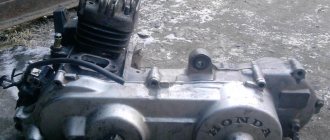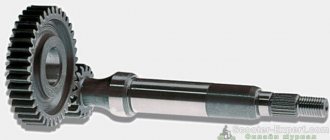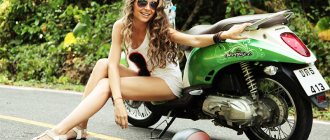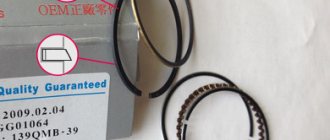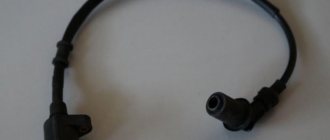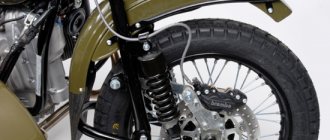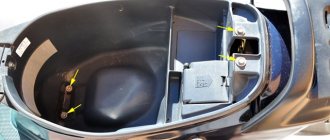Determining the release date of the scooter
One of the frequently asked questions when buying a used scooter is, “what year is it?”
Let's try to figure this out.
You can find out the year of manufacture in two ways:
2. Find a table with the year of manufacture on the plastic of the scooter itself.
Of course, someone may say: “what if the plastic was replaced earlier and, accordingly, the year of manufacture table on the plastic does not correspond to reality?” for reinsurance in this case, you can use the first option and determine the year of manufacture by the frame number using a special table.
But what to do if such a table is not at hand, and the year of manufacture needs to be determined right now?
The answer is simple: - we are looking for a table with the year of manufacture on the plastic of the scooter itself, it looks something like this
The column on the left shows the year and the column at the top shows the month in which the scooter was released.
Actually, in which cell the dot is located and the date of issue. If there are several points, then you need to navigate by the last one.
These tables can be located in different parts of the scooter's plastic. Let me give you a few examples.
HONDATACT 50 (AF24) frame number: AF24-1057650, judging by the frame number it is 1989. We are looking for a table on plastic. For the HONDATACT 50 (AF24) model, this table is located on the inside of the front glove compartment lid.
We look at the sign. It turns out that this Tact was released in May 1989.
HondaTACT 50 (AF16) frame number: AF16-1080787, judging by the frame number it is 1987.
The table on the HondaTACT 50 (AF16) is located under the seat. Judging by the table, the release date is May 1987.
On Honda DIO 50 mopeds, most often the table with the date is indicated on the plastic cover that covers the gas tank (next to the fuel tank). The Honda DIO 50 (AF18) is an exception; its table with the date is located in the same place as the HondaTACT 50 (AF16), i.e. under the seat.
HondaGIORNO 50 (AF24). In GIORNOAF24, the table is located under the plastic that covers the battery on the tray.
The same situation applies to the Suzuki Lets 50 (CA41A). The table with the release date is located under the plastic on the cover.
Honda CREA SCOOPY 50 (AF55), the location of the table with the release date in this case is approximately the same as that of the Honda DIO 50, i.e. on the back of the cover that closes access to the gas tank.
After looking at options for 20 different mopeds, I realized that in most cases the year tables are located in approximately the same places.
Most often, tables with the release date of the scooter are located in the following places:
2. if there is a front glove compartment, then on the inside of the plastic that covers the glove compartment;
3. under the plastic on the tray if the battery is located in the tray;
4. on the inside of the cover that blocks access to the gas tank, if it is, for example, a HondaDIO scooter.
Call center 24 hours. Any questions from those. consultations to assistance with placing an order.
Warranty on all products
Warranty for goods from 6 months to 3 years. If there is a defect, we will replace the product without any questions asked.
Secure payment methods
Pay by credit card, PayPal, bank transfer or cash upon delivery.
Delivery throughout Russia
You can choose delivery by courier, Russian Post or at a pick-up point.
We will pack it well, send it for delivery and monitor the order until delivery.
Compact transport
A scooter, or moped, is a small motorcycle, its engine is located below the driver, namely, under his seat. If the user mainly moves alone, without passengers, this device is the best option
The main reason is maneuverability, which is very important in urban environments.
The larger the city, the more justified the use of a scooter. The second, no less important reason is efficiency. Why pay more for fuel if it does its job functionally as a means of transportation? And if we see that it is impossible to argue with the necessity and expediency of purchasing a scooter, the first question arises: how to choose a scooter or moped? To do this, let’s try to understand the main features and selection criteria.
Where to find the frame and engine number on a scooter
and the Suzuki frame number is also located there . The fin is the lowest part of the scooter frame. The location of the code differs in different Suzuki scooter models.
engine model and can be seen at the top of the rear of the variator on the located platform.
Some information can be read on a paper or metal sticker with a number by opening the trunk of the scooter.
If you cannot find the frame or engine number on your scooter, write in the comments - we will try to help you. Good luck!
To watch online, click on the video ⤵
What is encrypted in the engine number of your Alpha or Alpha RX moped?Read more
How to find out how many cubic meters the engine is on an alpha delta mopedRead more
How to determine the cubic capacity of a 1P39 engine! 125 or 110 cubes? Moped Alpha.More details
Determining the cubic capacity of an Alpha moped | DeltaMore details
I disassembled three engines of the Alpha moped. What is the difference between a 125 cc engine and a 50 cc motor? How to make 110 cc from 50 Read more
Alpha (Delta, Sabur, Cub) engine repairRead more
Documents for a 49.9 cm3 moped, what needs to be shown and what not to the traffic police inspector in the Russian Federation! Read more
How to prove to traffic police that you have 50 cubes and not 110. Moped Alpha RX 11More details
Overview of the 110 cc engine. Alpha mopedRead more
The pistons are the same, but the volumes are different on the Alpha moped. Read more
How to find out how many cubic meters the engine is on an alpha delta moped!Read more
ASSEMBLY OF A 110 CC MOPED ENGINEMore details
What knocks at idle on an alpha mopedRead more
How a four-stroke scooter engine worksRead more
The best drive sprocket for Alpha, Delta mopedRead more
Review of the 125 cm3 engine for the Alpha mopedRead more
TUNING ALPHA 50 CUBES TO 150 CUBES. POSSIBLE?More details
Moped engine overhaul (Part 1)More details
Source
How to find out the year of manufacture of a Honda scooter
I was told that this is supposedly a dio 34 of the latest build. There's a big muffler with holes, a central lock, and a gas tank cap with a lock. Everything is original (except for mirrors), even tires and Akum. Scoot is finally in excellent condition. The seller said that the air intakes were cleaned, the compression was measured (10.5) and the variator was opened - they looked at it and didn’t change anything, they said that everything was original and in good condition. And he didn’t go into the engine at all, he said (and you can see it from the bolts). I bought it through connections. Not far from the muffler mount there is a stamp - GBLK, in the glove compartment there is a sticker with the inscription SK50MM1 VIII - what does this mean approximately? I wanted to take pictures of everything today, but my camera died. Everything will come later
I'm 100% satisfied with the Scoot, rushing along without failures - in 10 seconds it accelerates to 60 quietly. It starts in the cold from the starter on the first try, then picks up speed, warms up and drops. The speedometer at the time of purchase showed 2873. I drove a full tank and it was enough for exactly 89 km. I drove no more than 50 km as I was told. But on the first day I rode I checked - I calmly put the needle over 60, but then there were strange sounds. It's just a commotion there, strangled. I'll post photos soon
Opening of the 2021 motorcycle season. Revitalizing the Dnepr
Hi all! The weather has become quite warm in Belarus and I decided to wake up one of my motorcycles, the Dnepr, from winter hibernation. I put it in for the winter in October and have never started the engine since then. Having pulled the motorcycle out of the garage, I checked the oil level, pumped air into the wheels, poured fresh gasoline, connected the battery and. Nevermind. Didn't start. I unscrewed the spark plugs, checked for spark - no. The reason was found quite quickly: the ignition contacts oxidized a little while parked and due to poor contact there was no spark. After cleaning the breaker, I tried to start it again; it started to seize, but it would not start. The reason for this is a frankly weak piston. I plan to replace it a little later, since I have repair pistons. My brother and friend launched it “from the pusher”. It started working smoothly and smoothly, all electrics are working properly, oil pressure is 4 kg/cm. We drove it for a while and put it in the garage to wait for it to warm up and replace the piston. Overall, I'm happy with the motorcycle) Happy spring everyone! Thank you for your attention)
As usual, for those who prefer to watch rather than read, there is also a video:
Decoding the engine number of a Chinese scooter
Let's look at the decoding of the engine number in more detail. As a rule, the engine number begins with an abbreviation of letters that tell about the plant where it was manufactured.
It is noteworthy that the absence of an abbreviation may indicate the clandestine origin of the engine. The same thing happens if the scooter manufacturer ordered an engine from a “non-name” company.
This is followed by the number 1 or 2. This is an indicator of the number of cylinders. Usually cylinder 1, but for some reason this is always indicated. To make it easier to perceive information about the engine number, let’s take an arbitrary number as an example:
The first two letters LAA are visible, now we know what manufacturer of the scooter it is. Next comes the number 1, this is the number of cylinders.
The next letter P will tell you about the location of the engine. It can be horizontal or vertical. The horizontal model contains the letters P in the number; the vertical engine does not have this letter.
The next number is 39. This is the diameter of the cylinder. In this case, it says that the engine is fifty dollars, but often the manufacturer lies by installing a larger cylinder, thereby increasing the volume. Although he sells the scooter for fifty dollars and is not even shy. This step is forced, because the four-stroke Chinese fifty-kopeck car doesn’t want to go at all. It is much easier to increase engine capacity than to play tricks with other elements.
Next we see the letter F; the letter Q may appear instead. Most Chinese scooters are equipped with air-cooled engines. Moreover, this cooling can be either natural or forced. A striking example of natural air cooling are mopeds such as Delta, Alpha, Activ and the like. Forced air cooling can be found on scooters where air is sucked in from the side using a cooling impeller.
In our case, after the letter F we see the letter M. It indicates a motorcycle type of engine.
Next is the letter A. But there may be another one, more on that. Chinese scooter engines can range from 50 to 250 cubic centimeters. There are several degrees from minimum to maximum volume, and each level is indicated by the factory with a special letter. More details in the table:
As mentioned above, often the designation does not correspond to the actual volume, but deviations usually occur with scooters with a minimum cubic capacity.
Next we see the number 09. This is the year of manufacture, these two numbers. Now we know that our scooter is a 2009 model.
But the next 6 digits, in our case it is 013 521, are the engine number. For example, our model is 13521 in production order.
As you can see, the engine number of a scooter says a lot. Everyone should know this information about their iron horse.
What documents do you need to carry with you on a moped up to 50cc?
Hi all! I figured out the following question: what documents on an Alpha moped up to 50cc should you carry with you and hand over to the traffic police inspector for verification.
Let's see what is written in the rules. It says that any equipment - moped, mokick, scooter, according to the law of the Russian Federation, is classified as a moped. The main thing is that the engine should be up to 50cc, and the design speed should not exceed 50 kilometers per hour.
This means that if a traffic police officer stops you and asks you to present documents for a moped check, then you are legally obligated to hand over only a driver’s license that has category “M”.
Or any other category listed in Article 25, paragraph 7. of Federal Law 196. Screenshot from Article 25. Basic provisions regarding permission to drive vehicles
It turns out that any category allows you to drive a moped. If there is a category for driving a passenger car, like mine, then I can easily ride a moped up to 50cc.
My new license already indicates category M.
And that’s all! You are not required to show any more documents by law. And if the inspector starts singing in your ears, then remind him of the traffic rules, paragraph 2.1.1. Where does it say that you must have with you and present upon request to the police a driver’s license for permission to drive a vehicle. Next, registration documents for this vehicle (except for mopeds). And if there is a trailer, also on a trailer (except for trailers for mopeds).
If, despite this, you are issued a report on the absence of registration documents, then feel free to write - I do not agree with the traffic police inspector. The moped does not require registration and therefore no registration documents are required for it.
Feel free to go to court with this protocol and write a statement about abuse of power to the prosecutor's office.
You, of course, can take with you the instruction manual and the purchase and sale agreement. But you don’t have to show these documents to the inspector if you wish and according to the law. Moreover, you are not obligated to do this. Yes, there are situations where showing these pieces of paper will save you a lot of time.
But the inspector may refer to the fact that the moped may be stolen, or make sure that you are the owner of the moped, then you have the frame number and engine number on the moped. Let him compare and check them. And whether you are the owner or not, you don’t have to prove it.
Although, on the other hand, you can take a photocopy of the purchase and sale agreement with you. It's not difficult and can save you from wasted time.
Other answers in this thread
Piston killer and road mastodon
#4 Dan4ik
Here's how to decipher the UNIQUE NUMBER code. To broaden your horizons, remember the interpretation of the identification number of any motorcycle, the so-called VIN number (Vehicle Identification Number), using the example - JH2PF010021003231. The first three characters of the VIN number make up the WMI code (World Manufacturers Identification): J – country of manufacture (Japan), H – motorcycle manufacturer (Honda), 2 – manufacturer’s division. Next are six characters of the VDS code (Vehicle Description Section - vehicle descriptive code), the logic of which is determined by the manufacturer himself: PF0100. And the VIN number is completed by a sequence of eight characters of the VIS code (Vehicle Identification Section - vehicle identification code), the first digit of which shows the year of manufacture, the second - the assembly plant, and the last six characters - the serial number of the model: 21003231.
Our popular engines
CB250 169FMM (165FMM, 166FMM) ZONGSHEN
We all know the engine called CB250 from Zongshen, branded as 169FMM (230cc) and its twin brothers 165FMM (223cc) and 166FMM (225cc). These engines have their roots in Honda's MD33 and feature an overhead camshaft, two valves and air cooling. The declared power for all is around 16-17 hp. Installed, as a rule, on entry-level sports cross/enduro, such as ZUUM PX220, Motoland XR250 cross and WRX250, Kayo T2 and K1, BSE J1 and others
CG250-B 167FMM
There is another very popular and similar in characteristics, but not in design, lower engine with a balancing shaft, which is designated as 167FMM. It has a similar power of 16 hp. This engine is installed on inexpensive road models, as well as on dual-purpose enduro motorcycles, such as the Motoland XR250 Enduro and Enduro 250 LT, Racer Panther 250 and previously on the Irbis TTR250 Enduro
SONY DSCCB250-F 172FMM ZONGSHEN
Nowadays, the Zongshen engine, beloved by many, is the 172FMM, with a displacement of 249 cm3 and a power of 21 hp. It is nothing more than a fairly seriously modernized CB250 169FMM. In addition to the displacement, there were quite a few changes, thanks to which it was possible to achieve an increase in power of around 30%, which is quite cool considering that the volume only increased by 10%. But this engine also has a drawback - vibration, like on a vibration stand. The 172nd engine with a balancing shaft should appear soon, but in the first half of 2020 there is no such thing in Russia yet. Installed by most manufacturers on sports cross/enduro motorcycles in the average price category for China, for example ZUUM CR250CB, Motoland TT250 and XT250HS, GR7 and GR8
SONY DSC
NT300 170FMN YINXING
In our country, I have only seen such an engine on Racer motorcycles. Its working volume is 270 cubic meters and its power is about 20 hp. This is a direct competitor to the 172 engine, but has a little more torque and no vibration, thanks to the balancing shaft.
CB250 170MM-2 ZONGSHEN
Another engine called CB250, but labeled 170MM-2. Created on the same base as 172FMM. It has a volume of 249 cm3, a four-valve head, liquid cooling and a power of about 25 hp. Vibrates just like his little brother. At one time, this not the most common engine was installed on the Kayo T5 and is still installed on the Motoland XR250 Pro and WRX250 Lite WFA
CBS300 174MN-3 ZONGSHEN
And this is a modification of 170mm-2, only with a volume of 279.5cc and a power of 25 hp. It also has 4 valves and liquid cooling. In addition, one significant drawback of the engine, vibration, was eliminated by installing a balancing shaft. The engine has recently appeared on our market, but I’m sure it will find its client. In terms of power, it is not far behind the 177MM, but at the same time noticeably cheaper. Low end traction is even better. But its road origin and, accordingly, the kick starter and gearbox foot located not in the best way for enduro are its main drawback. Installed on enduro motorcycles ZUUM CR300CBs, Racer X2, BSE J7
NC250 177MM and NC300 184MN ZONGSHEN
The most popular, and before the appearance of the 450 on the market, also the most powerful Chinese engine with dropsy, is of course the ZS177MM, with a volume of 250 cm3. The engine is equipped with a four-valve cylinder head and liquid cooling, producing 28 hp. Nowadays, the version of this engine with a bigbor is extremely popular, increasing the volume to 297 cm3 and power to 31 hp. According to the labeling rules, it could be called 184MN, but this is essentially a tuning, albeit sometimes a factory one. Installed on a huge number of motorcycles, ZUUM CR300 NC and CX300 NC, Avantis 300 Pro, Motoland XT300 ST, BSE and others.
SONY DSC
NC450 194MQ ZONGSHEN
At the moment, this is the top Chinese engine in terms of volume and power from Zongshen. It has water cooling, 4 valves, a volume of 449 cm3 and a power of as much as 38 hp. Present in the lineup of most manufacturers.
TOP 10 best
Choosing a new handbag or sneakers is much easier than buying a scooter. This is an important choice that will determine your comfort on the road. Therefore, study the list of the TOP 10 most interesting and popular models of small two-wheeled vehicles. Here are only the best positions, according to owner reviews, as well as the main characteristics.
Stels Skif 50
This is an inexpensive model that costs less than even a computer or a bicycle. But this does not mean that Stels Skif 50 is inferior in quality. It is very easy to operate, has a large trunk, a protective cover and a reliable alarm system. The braking system is installed at the front, and the rear mechanism has a drum design. The engine runs quietly and you can start the engine using the key fob. The manufacturer provides a guarantee for this model for up to two years.
Characteristics:
- Engine power - 4.5 hp.
- Working volume - 49.8 cm3.
- Maximum speed is 65 km/h.
- Total weight - 78 kg.
- Country of origin: China.
Advantages:
- thoughtful design, various colors;
- low price;
- large trunk;
- quiet motor operation;
- 2 year warranty;
- fast, convenient start from the key fob.
conclusions
Need to go to the market or supermarket? The maneuverable model will quickly get you to your destination, and the spacious trunk will allow you to bring home food for a week.
Irbis LX 50
Inexpensive and at the same time high-quality, fashionable scooter. It is made in a sporty style and will appeal to boys and girls. There are two large headlights at the front, which perfectly illuminate the road in the dark. Off-road tires allow you to move on dirt roads. You can accelerate the vehicle up to 90 km per hour. There is a second seat for the passenger, although the speed then becomes slower. The suspension is reinforced, there is an alarm system, remote engine start, and durable aluminum wheels.
Characteristics:
- Engine power - 6.5 hp.
- Working volume - 50 cubic meters. cm.
- Maximum speed is 90 km/h.
- Weight - 100 kg.
- Country of origin: China.
How to distinguish a 166FMM motor from a 172FMM
And now let's move on to the most important question, so how to distinguish the 166FMM engine and its brothers from the more powerful 172FMM engine? We discard the disassembly of the engine immediately)))
If you want to buy a motorcycle with a real ZS172FMM-3A engine, please contact our store
Motolifeshop.ru , we will be happy to help you.
Still have questions?
I will be happy to answer them in personal messages on VK vk.com/evgeniy.naboka or by email
[email protected] Well, this article was prepared for you by
Evgeniy Naboka .
If the article was useful, please like and subscribe to this channel! Until next time and see you on the rides!
Appearance of Alpha RX
Alpha RX is an updated version of the previous classic moped. The new moped has become more interesting and elegant in appearance. The exterior has a modern look which I liked. The tank has been updated, a two-level seat has been installed - the passenger is now slightly higher than the driver. The passenger's visibility is now better. The wings are now made of plastic, but only the front wing is painted. This already saves the wings from corrosion.
The headlight became larger than that of the classic Alpha, a serious halogen lamp was installed, and the light became brighter. The rear shock absorbers have become more advanced in shape. The motorcycle is also equipped with serious lighting equipment - front and rear lights, turn signals with sound, high and low beams, a signal and a brake light.
Very easy to use. Repair is possible with a minimum set of tools, but you will have to stock up on additional open-end wrenches: 9, 11 and 15.
It comes in two versions for sale: with a 72 cc and 110 cc engine. But lately they have been supplied partially unserviceable with a 50cc piston that will need to be upgraded. These versions of the models are called Alpha 7 and Alpha 11.
These numbers are deciphered as follows:
Initially, these models cost like “fifty dollars” and they will not be able to drive. In any case, they will have to be modified. But according to the documents, they are like mopeds with 49.9 cubic meters and there is no need to register them with the traffic police. The only thing you need is a driver's license of any category.
Engine markings of Chinese scooters
Chinese scooter engines can be two-stroke or four-stroke. All of them are produced directly in China by the scooter manufacturer or on order from a third-party company. Usually, no one is involved in the development of something new, since it is expensive, time-consuming and requires noble minds, of which there are not very many in this country.
Hence, all production lines are Japanese originals or slightly modified conveyors. Simply put, the engine that is on your Chinese scooter was on a Japanese Yamaha, Honda or Suzuki 15-20 years ago.
It is interesting that the Chinese have learned to make four-stroke engines better than two-stroke engines, hence their quality is somewhat higher. This means that a Chinese-made chotiritactic will be more reliable than two-stroke ones. There are also analogues of European models from the 80s and 90s, but there are very few of them.
Tuesday, April 17, 2012
Engine markings for scooters and mopeds, as well as some explanations.
Hello. Today we will talk about engines on scooters and mopeds, what they are and what they are. And so, let's start with the majority of 4t Chinese mopeds. Such as Alpha, Delta and the like. They are equipped with a 139FMB engine. This engine was developed by Honda for the Honda Super Cub moped. Look for spare parts by marking 139FMB and some are suitable from Honda Cab. Now let's talk about engines on 2t Chinese scooters. They come in 2 types, CVT and chain. Let's start with the first type - chain. This engine is similar to the 1985 Suzuki Ran engine. With a chain drive, therefore all spare parts are identical to spare parts from this engine. Basically, the engine is very capricious and runs very poorly, which is why I wouldn’t recommend it to anyone. The second type of two-stroke engine is the 1P40, this engine is a converted copy of the Yamaha 3KJ engine that was installed on the Yamaha Jog model. For spare parts, it is advisable to contact a Stels scooter dealer, as they actively use this engine. A distinctive feature of the variator. 4t Scooters China. The 139QMB engine is mainly used in 50cc scooters. The current “charged versions” are now labeled 147QMB, which is somewhat noticeable. 152QMB and 157QMJ are engines that are used on Chinese scooters of 125 and 150 cc, respectively. Now let's move on to Japanese scooters. Let's start with Yamaha. The Yam family had several scooters. Yamaha Mint - their engine was not customarily labeled in Russia, so look for spare parts from Yamaha Mint, do not confuse it with BM Mint, it has an engine from Suzuki Ran. Yamaha Jog (old air cooled models) 2t - 3KJ - but do not confuse with the Chinese engine, different clearances.. Yamaha Jog R and RR - different liquid cooled, minarelli engines, so look for parts by model name. Yamaha Vino and others, most often, are Jog conversions with 3KJ installed on them. All new 50 cc Yamahas have a Minarelli engine with a bunch of exhaust gases for eco-standards. Suzuki. All models except the Run-F from the old ones have an engine from Address - 50 and therefore this engine is called AD-50. There is also a new model Suzuki Avenis - its analogue is actively sold in Europe under a different name (like Hurricane). Honda Dio - there are several types of engine depending on the moped. AF18.25 - AF18E AF27.28 - AF18E AF34.35 - AF34E New engines have new markings, check in the showrooms. Honda Pal, Tact AF09E, AF16 - AF05E engine. At the moment I have no information on newer measures. Honda Lead 50, Joker 50 - Referred to as Honda Lead, with 90 cc engines, a similar situation. I have no information on the new Honda Lead and Lead 100.
What oil should I use?
Available types of oils for four-stroke engines: SAE 5W-20 or 10W-40. Depends on the manufacturer. If the vehicle is often operated in high temperature conditions, it is better to choose a motor oil with a high viscosity index.
What to look for when choosing oil? First of all, on the oil indices, which should be present on the canister label. The chemical composition is also no less important. In addition to the index, the exact amount of additives from the fluid manufacturer is used.
For a four-stroke scooter engine, you can use not only oil that is intended for scooters, but also for equipment: walk-behind tractors, lawn mowers, chainsaws and others.
Appearance of Alpha RX
Alpha RX is an updated version of the previous classic moped. The new moped has become more interesting and elegant in appearance. The exterior has a modern look which I liked. The tank has been updated, a two-level seat has been installed - the passenger is now slightly higher than the driver. The passenger's visibility is now better. The wings are now made of plastic, but only the front wing is painted. This already saves the wings from corrosion.
The headlight became larger than that of the classic Alpha, a serious halogen lamp was installed, and the light became brighter. The rear shock absorbers have become more advanced in shape. The motorcycle is also equipped with serious lighting equipment - front and rear lights, turn signals with sound, high and low beams, a signal and a brake light.
Very easy to use. Repair is possible with a minimum set of tools, but you will have to stock up on additional open-end wrenches: 9, 11 and 15.
It comes in two versions for sale: with a 72 cc and 110 cc engine. But lately they have been supplied partially unserviceable with a 50cc piston that will need to be upgraded. These versions of the models are called Alpha 7 and Alpha 11.
These numbers are deciphered as follows:
Initially, these models cost like “fifty dollars” and they will not be able to drive. In any case, they will have to be modified. But according to the documents, they are like mopeds with 49.9 cubic meters and there is no need to register them with the traffic police. The only thing you need is a driver's license of any category.
Engine Features
The official manufacturer of the 139QMB scooter engine is Hongling Corporation, which equips motorcycles not only of its own brand, but also of other brands with this engine.
The corporation sells power units to other manufacturers. The motor itself is very recognizable: the design features of the 139QMB engine and its markings on the left side of the crankcase immediately make it clear what kind of heart beats the scooter.
The motor has no flaws, does not require special treatment and calmly tolerates minor negligence and negligence. The manufacturer provides a guarantee for its products that covers the first 5 thousand kilometers. This mileage is enough for the new 139QMB 4t scooter engine to fully run in and grind in all elements and components of the systems.
The total service life of the engine is about 20 thousand kilometers, with the exception of 5 thousand running-in at an average driving speed of 90 km/h. The technical characteristics of the 139QMB engine are not bad: its power is enough for a two-seater full-size scooter.
Another acquisition
Hello everyone!) I’m sharing a new little joy - I bought myself another motorcycle, a Chezet 472.6, produced in 1986. Bought yesterday for little money from a good friend. For the last 15 years it just stood there, rusting and becoming covered in dust.
The mileage stopped at 79,000 km, then he drove for several more years with a non-working speedometer. In the 90s, it was not without some tuning - the turns were moved to the arches and two sound signals were installed) The arches were also self-made, because the thin relatives could not withstand several falls
I put it in the garage, during the winter I will restore it to running condition and next season I will drive it. This season I still ride the Dnepr and a little on the IZ Jupiter 5:
The Java that I wrote about earlier is standing there, waiting for its turn, the necessary spare parts are being purchased, everything is being put together separately, so that later in one fell swoop it can be taken over and sorted out completely at once. That's all for now, I will add posts later as the work progresses. Thank you for your attention!
Where can I find the scooter frame number?
First you need to decide why you need the scooter frame number. Usually they look for it in the hope of establishing the year of manufacture of the scooter (if it was not possible to determine the engine number), if there are doubts about its age, and, consequently, mileage.
Naturally, the frame number may be in different places on different scooters. But, as a rule, you should look for the frame number either under the steering wheel on the driver’s side (in this case it can be hidden by a special flap or cover), or on the very bottom of the frame - in the sill (there is a special window there).
If we consider specific brands of scooters, the location of the frame numbers also varies. For example, the frame number of Suzuki scooters is usually marked on the fin, that is, on the very bottom of the scooter frame
However, it is worth paying attention to the fact that the location of the code is different on different models of Suzuki scooters. If we talk about Honda scooters, the frame number on them is usually located in the box under the plastic cover
Another option for marking the frame number on Honda scooters is a special window on the left side of the plastic threshold of the scooter. On Yamaha scooters, the frame number is located on the bottom of the frame itself, that is, to identify it, you need to lay the scooter on its side. Also, the frame number on Yamaha scooters may be located under the ignition switch cell - you just need to remove the small plastic plug to see it.
If we talk about the location of the frame number on European-made scooters, then you can almost always find it under the footrest - you just need to bend the plastic a little. However, it all depends on the specific model.
The location of the frame number on Chinese scooters may be in different places on the scooter, but in general it almost completely repeats the placement on Japanese and European models.
So, no matter what model of scooter you come across, you can find the frame number in several places:
— The lower part of the frame (in the floor, under the step, on the side of the sill) - In the area of the ignition switch cell - On the steering fork
— Under the seat in the luggage compartment
You can also learn how to determine the year of manufacture of a scooter from the corresponding article on our website.
| Updated 12/01/2009 17:02 |
Specifications
The front fork of a scooter is an important factor when choosing a scooter. It can be of three types - telescopic, pendulum, lever. The telescopic fork can be considered the most modern, but it is also more convenient than others during city trips. However, to travel on country roads and rough terrain, choose a scooter with a pendulum fork, which is not so sensitive to potholes and better absorbs on uneven surfaces.
When choosing a scooter for an elderly person, a novice driver, a teenager or a woman, it is important that the device is low-power (no more than 3 horsepower) so that the person can handle the machine. Moreover, such a scooter can easily carry two people at a speed of 50 km/h
Also, for the above drivers, it is better to opt for a scooter with a lever fork, which provides maximum convenience and safety in driving the scooter.
When choosing a scooter for a teenager, do not forget that a license to drive a vehicle must be purchased when using a 50 cc engine. see. Japanese manufacturers equip their scooters with an engine of this size. European models have larger engines of 75, 125, 150, 180, 250 and even 500 cc. Chinese twenty-five cc engines are exactly what will suit your teenager. In addition, it is very economical. But if you buy a scooter for traveling around the city, remember that this power is negligible for constant city travel.
TIP: If you are looking for a scooter for country trips, pay attention to the location of the air filter - the higher the air intake is located, the better. With a lower intake, when riding on country roads, you will have to change the air filter very often, increasing the cost of operating the scooter several times. . The scooter engine can be two-stroke or four-stroke. The “advantages” of a two-stroke engine undoubtedly include high specific power, simplicity and lightness of design
At the same time, it can always be “upgraded” to more cubes. The advantages of a four-stroke engine include smooth traction at low speed, quiet operation, lower gasoline consumption and oil, which is changed only during maintenance, while a two-stroke engine consumes oil constantly
The scooter engine can be two-stroke or four-stroke. The “advantages” of a two-stroke engine undoubtedly include high power density, simplicity and lightness of design. At the same time, it can always be “upgraded” to more cubes. The advantages of a four-stroke engine include smooth traction at low speed, quiet operation, lower gasoline consumption and oil, which is changed only during maintenance, while a two-stroke engine consumes oil constantly.
Power. If a scooter becomes your daily vehicle, then it is better to choose an engine with at least 7 horsepower. You will spend no more than three liters of fuel per hundred kilometers. The power guarantees good maneuverability, which is very convenient in city driving conditions.
The transmission of modern scooters comes in several types:
- The most common option is a single-speed transmission, which is easy to use.
- The most modern and reliable option is a V-belt variator, the advantages of which are uniform and powerful acceleration and a confident start.
- Semi-automatic (semi-automatic transmission) is characterized by gear shifting using a foot lever. And perfect for novice drivers.
Preliminary work
Before repair work, the most initial, necessary diagnostics of engine components, inspection of repair accessories, assessment of weather conditions, etc. are carried out. To summarize, the list of preliminary work is as follows:


